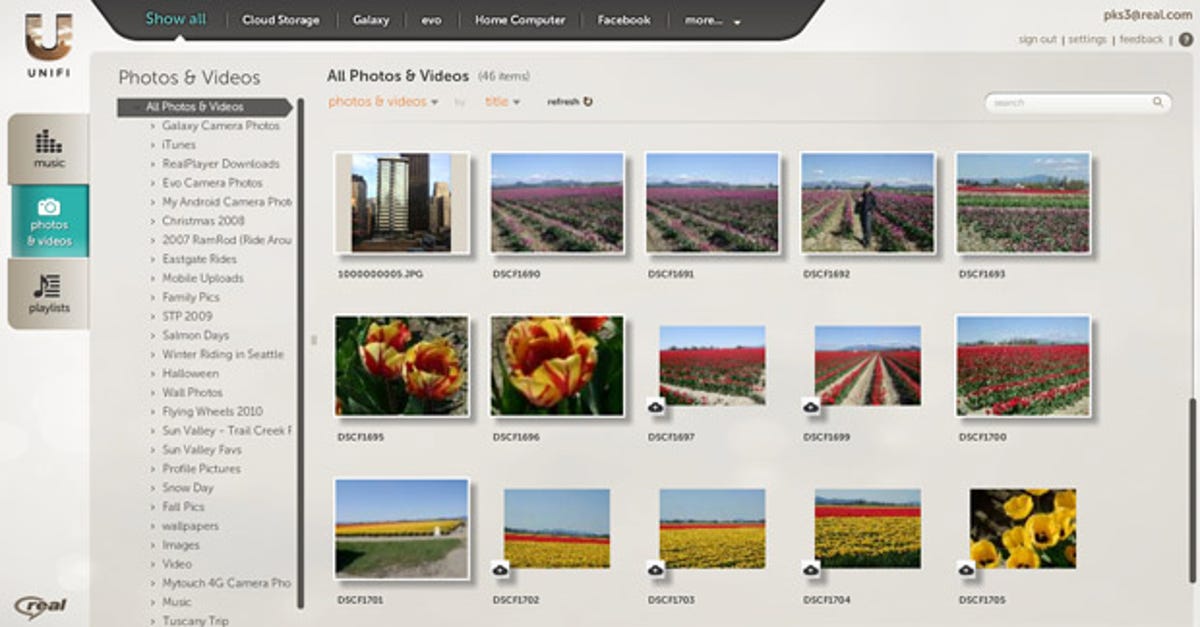
Having bagged an award at CES in January, RealNetworks’ Unifi service is already drawing quite a buzz ahead of its launch later this year. We sat down for a hands-on demo with Unifi this morning at Mobile World Congress, and came away impressed.
Here’s the problem it’s designed to solve: you have photos, music and videos scattered across a range of devices: computers, mobile phones and tablets. The music will likely be from a range of sources too: one or several digital stores, ripped from your own CD collection, or from torrents or other free sources.
“Media gets isolated on devices,” explained RealNetworks’ VP of emerging products Peter Kellogg-Smith, as he walked us through Unifi this morning. “It can sometimes be difficult to access music from one device to another, and the most common complaint we hear is that people’s pictures don’t make it off their smartphones.”
He also thinks there’s going to be a demand for cloud services because people are tiring of connecting devices to computers with cables to transfer their stuff across.
“People don’t like to tether-sync any more,” he says. “They just refuse to do it. One reason people avoid purchasing music on their iPhone is the fear they’ll have a hard time getting it back into their library.”
So what is Unifi, and why does it help? Kellogg-Smith was keen to stress that it’s not a ‘backup-and-sync’ service, like some rivals. That is to say you don’t point Unifi at a folder or folders on your computer to backup their contents to a remote server, and keep the two synchronised.
“We actually catalogue all your devices, all of the media, and upload the metadata to the cloud,” he said. “You can then manage all the media, even if the files themselves are not stored in the cloud.”
The screenshot above of the Unifi web client should make that clearer. Across the top of the screen, you see tabs for your devices – home computer, laptop, smartphone, tablet… whatever you’ve connected up to the service.
The left-hand tabs, meanwhile, switch between music, photos and videos, and playlists. Using a combination of the tabs, you can see what’s stored on any of your devices individually. When it launches, there will be apps for iPhone, iPad and Android tablets, with BlackBerry and Windows Phone 7 apps following shortly after, along with connected TVs.
Unifi may not be backup-and-sync, but you can upload stuff to the cloud — it’s just that you choose which albums, photos and videos to upload, rather than automatically syncing everything in a particular folder.
As we said, we were impressed. Unifi doesn’t look like a geeky file management tool: the web version’s layout is clean and clear, and the quick squizz we got at the Android app running on a Samsung Galaxy Tab looked equally easy to use.
The idea of regaining a modicum of control over our fragmented music and photo collections is a big selling point too. The question is how much it’ll be sold for. RealNetworks has not yet announced how much you’ll pay a month for Unifi, nor has it got a confirmed UK launch date.
Unifi is due to launch in the US in the second quarter of this year, and RealNetworks is trying to do deals with mobile operators to offer it to their customers too, with Vodafone Germany being the first to sign on the dotted line.
If it’s affordable and people get a decent free trial to see if they like it, Unifi could be a hit. That said, it will face stiff competition when Apple and Google get their cloud services up and running later this year — just this week, rumours flew that Apple is planning to revamp MobileMe as a similar cloud service for music, photos and videos.
That will only work across iOS devices, of course, so RealNetworks is hoping its ability to span everything will give it an edge.



